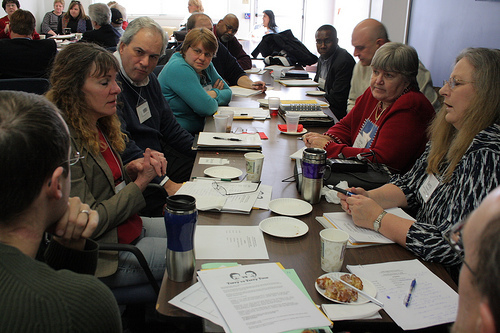Editor’s Note: This article is the second of two. Read the first here.
Many education leaders continue to insist the process for creating national education standards was “state-led,” referring to its incubation within two Washington DC-based nonprofits, the National Governors Association and Council of Chief State School Officers.
That seems to depend on how one defines “state-led.”
Former Virginia Gov. George Allen told School Reform News NGA is less a policy forum and more a networking opportunity, because any resolutions governors vote on are “not binding” and governors often disagree. He attended NGA meetings particularly so he could recruit IBM into Virginia.
“I find regional governors associations were much more practical,” he said. “You have similar concerns and similar philosophy.”
Somehow that unelected, unrepresentative networking forum quickly became a serious driver of education policy changes for the nation by creating and promoting Common Core, a list of what kids must know in math and English that 45 states have traded for their education standards.
How NGA Made Common Core
NGA first directly involved governors in nationalizing education standards in June 2008, when it co-hosted an education forum with the Hunt Institute, a project of former North Carolina Gov. James Hunt Jr. In December 2008, NGA, the Council of Chief State School Officers (CCSSO), and Achieve Inc. released a report calling for national standards. The report recommended “a strong state-federal partnership” to accomplish this goal.
Those three nonprofits answered their own call the next few months, deciding to commission Common Core. NGA and Hunt’s press releases during that time, and a paper describing NGA’s Common Core process by former NGA education director Dane Linn, provide no endorsement of such activity from more than a handful of elected officials. NGA spokesmen refused requests for comment.
On June 1, 2009, NGA and CCSSO announced 46 states had joined “a state-led process to develop a common core of state standards,” without explaining what “joining” entailed. Two weeks later, the June 2009 NGA-Hunt education forum featured direct national standards advocacy to the 21 governors and staff who attended—the invitation-only event does not release attendee names—and spliced in new U.S. Education Secretary Arne Duncan, who spoke of national standards as a federal-state partnership.
“[M]y job is to help you succeed” in adopting “common national standards,” Duncan told the assembly. He said states initiated Common Core because a Bill and Melinda Gates Foundation-funded 2007 commission of 15 people, headed by two former governors, had recommended national standards.
The federal government “empowers states to decide what kids need to learn and how to measure it,” Duncan said. One of the ways it would do that, he said then, was funding national Common Core tests.
Three Main Committees
By July 1, 2009, NGA and CCSSO had formed more committees. There were two work groups, whose dozen members in math and English wrote the standards. These included no teachers, but did include a few professors. Second were two feedback groups, who were supposed to provide research and advice to the writers. Those had 18 members each, who were mostly professors but included one math teacher. Third was the validation committee, announced in September 2009, which acted as the final gate for Common Core. Their job was to “ensure [the standards] are research and evidence-based.”
While many people sat on these various committees, only one in sixty was a classroom teacher, according to teaching coach and blogger Anthony Cody. All of the standards writing and discussions were sealed by confidentiality agreements, and held in private. While Linn says six states sent intensive teacher and staff feedback, committee members weren’t sure what effect their advice had, said Mark Bauerlein, an Emory University professor who sat on a feedback committee.
“I have no idea how much influence committee members had on final product. Some of the things I advised made their way into the standards. Some of them didn’t. I’m not sure why or how,” he said. He said those who would know were the standards’ lead writers: David Coleman and Susan Pimentel in English, and Jason Zimba, Phil Daro, and William McCallum in math. Coleman and Zimba did not have previous experience writing standards.
Several people on the validation committee said the same: They had no idea what happened to their comments once they submitted them.
‘Impossible to Deal With’
“The ‘facilitators’ for the validation committee meeting were virtually impossible to deal with,” wrote James Milgram, a Stanford University professor who sat on the committee, in an email obtained by School Reform News. “The facilitators were emphatically trying to not let us act according to our charter, but simply sign or not sign a [final approval] letter when the charter said we had final say over the quality of the final [Common Core] and could revise or rewrite it if we deemed it necessary.”
Five of 29 validation committee members refused to sign off on Common Core. The validation committee’s final report does not mention their objections. Its author later told Sandra Stotsky, another committee member, he had never received any written objections from committee facilitators, she said, although she and several others had sent them. He would have included them, he told her.
When government agencies solicit public comments on proposed policies, standard procedure is for the agency to publish all comments submitted and a response. This didn’t happen with Common Core.
“It’s like how laws are passed. Who wants to see how sausage is made?” Bauerlein said. “People want to look at what is the outcome: Are these standards good? It all depends on the curricula that gets created at the local level. You can have strong standards and end up with weak curricula. It’s happening in many places, in fact.”
This article has been corrected regarding CCSS lead authors’ experience writing standards.
Image by Jennifer Cowley.





